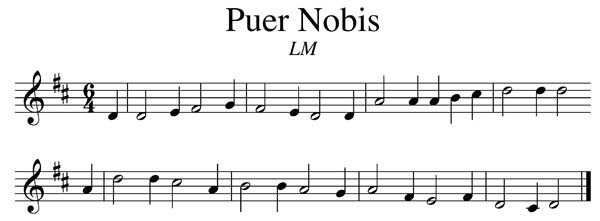 A 15th century melody found in a Trier manuscript adapted by Michael Praetorius (1571-1621).
A 15th century melody found in a Trier manuscript adapted by Michael Praetorius (1571-1621).
See a list of other popular hymn and chorale themes here.
 A 15th century melody found in a Trier manuscript adapted by Michael Praetorius (1571-1621).
A 15th century melody found in a Trier manuscript adapted by Michael Praetorius (1571-1621).
See a list of other popular hymn and chorale themes here.
This week I am attending the AGO National Convention in Boston. There will be several events that include organ improvisations during the week: a concert by Thierry Escaich, a Hymn Sing with Bruce Neswick and Pamela Ruiter-Feenstra, a silent movie accompanied by Peter Edwin Krasinski, and several workshops and masterclasses. You can see the complete list that I compiled here. While I am always excited to see many familiar people and hear some fabulous playing, one of the highlights for me at the national convention is always the National Compeition in Organ Improvisation (NCOI).
After a preliminary selection round by recording, five candidates were selected to participate in the semi-final round. For this round, the candidates will have 30 minutes of preparation time with the themes and then will be required to play 1) a historically inspired improvisation based on a given hymn melody, chorale tune, or plainsong and 2) an improvisation on one of the given free themes, or on one given free theme and a secondary theme of the contestant’s choosing. Total performance time for these two improvisations is a maximum of 27 minutes. While that may seem like a long time to improvise, most candidates usually create a suite of variations on the hymn, chorale, or chant, so it becomes a little easier to fill the time requirement with short manageable movements. In fact, over the years, I’ve seen a few candidates have to end quickly in order not to play too long!
A maximum of three candidates will then be selected to continue on to the final round. The requirements for the final round are 1) a prelude, fantasia, or toccata and a fugue based on given theme(s), which may be sacred or secular and 2) a free improvisation based on a given musical theme or a given nonmusical theme (literary passage or artwork). Total performance time is again limited to a maximum of 27 minutes.
How many of these tasks would you feel comfortable doing now? Even if you aren’t able to hear the competition this week, the AGO has previous competition recordings available in the AGO Store. I found the recording from Nashville in 2012 listed in the Organ Music/Essays/Catalogs category. It also seems like you may be able to obtain other recordings from AGO National if you call and ask.
Because I received a request to report on the competition from someone who is not able to attend, I decided to set up a twitter account and live tweet the competition. I’ll eventually post a summary at organimprovisation.com, but if you’d like to follow along as it happens, I’ll do my best to make it informative and entertaining. With everyone following the World Cup, here’s my chance to be the announcer for the “American Cup” of organ improvisation. Follow me at @organimproviser to see if improvisation can be more exciting than soccer!
After a week of competitions, concerts, and workshops, I hope to have more practical advice for you next week.
Hoping you are having a fabulous summer of learning and fun!
Glenn
Recent additions to organimprovisation.com:
Newsletter Issue 9 – 2014 06 23
See the complete list of past newsletter issues here.
Sign up to receive future issues using the box to the right on this page.
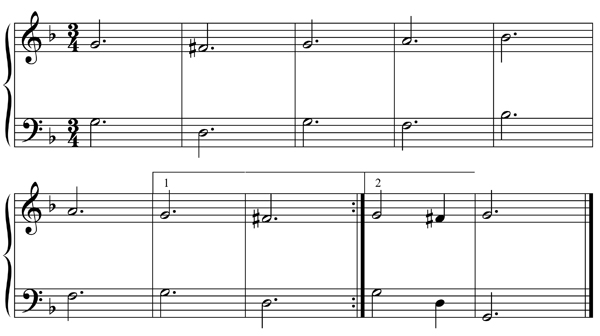 La Folía is one of the oldest European musical themes. Several sources report that Jean-Baptiste Lully was the first composer to formalize the standard chord progression and melodic line, though it’s origins are probably much earlier. With a standard chord progression and common melody line, it has been the theme for many sets of variations and may have first developed as a compositional or improvisational method for creating melodies in the minor mode.
La Folía is one of the oldest European musical themes. Several sources report that Jean-Baptiste Lully was the first composer to formalize the standard chord progression and melodic line, though it’s origins are probably much earlier. With a standard chord progression and common melody line, it has been the theme for many sets of variations and may have first developed as a compositional or improvisational method for creating melodies in the minor mode.
See a list of other free themes here.
Video:
Gunnar Idenstam – Improvisation on La Folia – Oscar´s Church, Stockholm, Sweden
The Beatles were an English rock band that formed in Liverpool in 1960. With John Lennon, Paul McCartney, George Harrison and Ringo Starr, they became widely regarded as the greatest and most influential act of the rock era. According to the RIAA, the Beatles are the best-selling band in the United States, with 177 million certified units. They have had more number-one albums on the British charts and sold more singles in the UK than any other act. In 2008, the group topped Billboard magazine’s list of the all-time most successful “Hot 100” artists, and as of 2014, they hold the record for most number-one hits on the Hot 100 chart with twenty.
Not only because of their popularity, but also because of their compositional style, the music of the Beatles has been taken and transformed into the realm of traditional classical music. Pianist John Bayless provided my first encounter with this crossover combination:
Bach Meets the Beatles
Labeled as improvisations, I couldn’t help but wonder how much these performances had been practiced and developed before they were recorded. Regardless of the level of preparation, the combination of popular melody and classical style became a fascination of mine that continues to this day. I even worked up my own composition of a TV theme and Vierne: Louis Vierne Meets ‘The Munsters’!
Now that I’ve seen the performance of Penny Lane in the style of Bach by John Bayless at the Newport Music Festival, I am convinced that if they started as improvisations, John Bayless has played them enough that they have become compositions. He promises a score to “A Hard Day’s Night’ coming soon on his website and there are videos of others playing the piece now on YouTube.
So, even if we won’t be playing Michelle, any time soon at church, there are times in concert when organists do improvise on Beatles tunes:
Evert Groen – Improvisation(Sonate) on ‘Obladi-Oblada’ – Saalkirche, Ingelheim am Rhein
Evert Groen – Improvisation on ‘Hey Jude’ – Wirges Cathedral, Germany
Bert Rebergen – Improvisation on Rock & Roll/Yellow Submarine/Yesterday – Sionskerk Veenendaal
or even simply play Michael Jackson:
Albinas Prizgintas – Billie Jean by Michael Jackson – Trinity Episcopal Church, New Orleans
Now that we’ve had a little fun listening to others explore the Beatles and other pop tunes, is there something we can do to apply any of this to the hymns and chants that we are more likely to face on Sunday morning? What does John Bayless do to the Beatles’ tunes to transform them into the style of Bach? What elements of his performances can we identify as belonging to Bach? Are there textures or forms that we can identify and apply to other themes? I believe that listening to others improvise gives us a new window on both style and the creative process.
I once took a multiple day workshop from Thierry Escaich where he demonstrated the styles of many composers. What amazed me most was that regardless of whether he was playing in the style of Bach, Mozart, Brahms, or Cochereau, he always sounded like Escaich! It was a lesson not simply in the style of the composer, but the improviser as well! (If you will be at the AGO National Convention in Boston, you can here Escaich both perform and teach. He is someone not to miss!)
After listening to others and asking questions about what we hear, the nest step is always to go out and try it. Maybe you won’t be asked to improvise on the greatest hits from the Billboard 100 this week, but I would encourage you to look “outside the box” for inspiration. How many different ways can you treat the same theme? Which styles are you comfortable with? Which would you like to learn? Have some fun and expand your horizons!
May your summer be filled with listening fun!
Glenn
PS If you’d like to hear a fabulous catalog of 20th century popular piano styles, check out Scott Bradlee’s version of Twinkle, Twinkle, Little Star!
Recent additions to organimprovisation.com:
I have decided to review a book or CD every Saturday. As one of the essential library items for any organist improviser, the first up is Improvising: How to Master the Art by Gerre Hancock.
Newsletter Issue 8 – 2014 06 16
See the complete list of past newsletter issues here.
Sign up to receive future issues using the box to the right on this page.
“Twinkle, Twinkle, Little Star” is a popular English lullaby. The lyrics are from an early 19th-century English poem, “The Star” by Jane Taylor. The poem, which is in couplet form, was first published in 1806 in Rhymes for the Nursery, a collection of poems by Taylor and her sister Ann. It is sung to the tune of the French melody “Ah! vous dirais-je, Maman”, which was first published in 1761 by François Bouin in La Vielleuse habileand. It was later arranged by Mozart for a famous set of variations. Many other texts for this melody exist in English, German, and even Vietnamese!
Twinkle, twinkle, little star,
How I wonder what you are.
Up above the world so high,
Like a diamond in the sky.
Twinkle, twinkle, little star.
Ah! Vous dirai-je Maman
Ce qui cause mon tourment?
Papa veut que je raisonne
Comme une grande personne
Moi je dis que les bonbons
Valent mieux que la raison.
See a list of other potential traditional song themes here.
Now that we’ve explored the Four C’s of Improvising (Competency, Convincing, Coherent and Colorful), the question becomes how do we apply them all at once? If our improvisations are to sound like a composition, then we must be able to master all of them, but where do we start? Is there an order that we need to cover them in order to master the art of improvisation?
I have always looked at my improvisation skills as a tool box. A house or even a piece of furniture is constructed using not just a hammer, but a hammer, screwdriver, saw, nails, pliers, and depending upon the project, perhaps a measuring tape, a few wrenches, a blow torch or even a backhoe! So constructing a piece of music also requires use of harmony, counterpoint, and many other musical tools. It can be advantageous to practice these areas separately, but eventually we must combine them together if we are to achieve a final product. Mastering harmony alone would be like mastering the saw. There are many things we could do, but we will need more tools to complete our project.
Because there are so many tools that we need to master in order to improvise, I have become fascinated by the method books that have been written to teach improvisation. I am attempting to compile a bibliography of books here. Please let me know about others and I will add them to the list. Each of the books I have seen chooses a different place to start and covers different tools.
For example, one of the recent books I found is Harmonizing: A Method to Encourage the Art of Improvising by Sietze de Vries. As the title implies, this book is aimed at organists beginning the study of improvisation. The first pages explain root position triads, inversions, and basic harmonic progressions. The next few chapters build out from this base by expanding to other major keys, applying the inversions, widening the harmonic palette, and then moving into minor keys and church modes. If you do not have a solid foundation in harmony and theory, then this could be a good place for you to begin your study. As the author says on the last page:
And now a somewhat discouraging announcement: This is only the beginning! The knowledge you have gained about harmonizing can help you begin to improvise hymn introductions and choral preludes. This makes knowledge of different musical forms absolutely necessary.
Indeed, I find this book to be very basic and something I am not likely to use myself except as a thematic resource. It includes over two dozen simple chorale themes from the Dutch Liedboek voor de kerken. If you don’t have access to that hymnal and need some simple themes to work with, this could be an excellent resource. Here’s a sample theme, Lobt Gott den Herrn, ihr Heiden all:
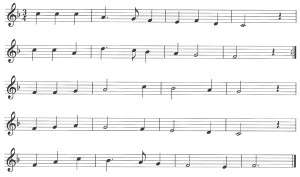
Rather than search through Bach’s 371 Harmonized Chorales for simple chorales, Harmonizing by Sietze de Vries will provide you with plenty of useful themes to practice not just harmony but many other tools from your toolbox that you might wish to develop. What sort of introduction or chorale prelude could you make with the theme above? If this is the starting place, where would you go next? How many different places can we go from here? Rather than be discouraged, I get excited by all the possibilities! We have a start, so let the adventure begin!
Hoping you will explore the possibilities,
Glenn Osborne
Recent additions to organimprovisation.com:
Newsletter Issue 6 – 2014 06 02
See the complete list of past newsletter issues here.
Sign up to receive future issues using the box to the right on this page.
In square notation:
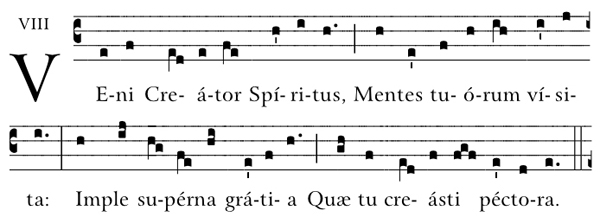
or regular notation:
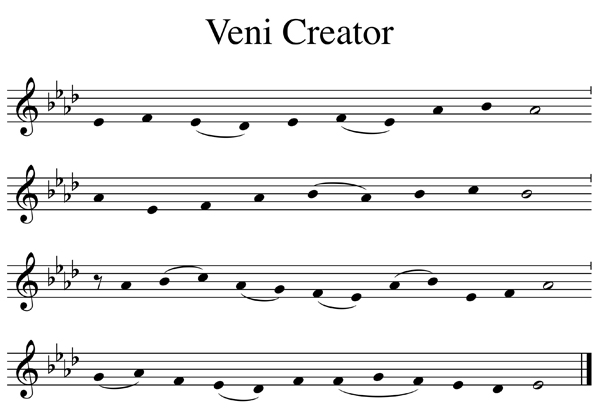
Veni Creator Spiritus is a hymn believed to have been written by Rabanus Maurus in the 9th century. It is sung during the liturgical celebration of the feast of Pentecost (at both Terce and Vespers). It is also sung at occasions such as the entrance of Cardinals to the Sistine Chapel, when electing a new pope, as well as at the consecration of bishops, the ordination of priests, when celebrating the sacrament of Confirmation, the dedication of churches, the celebration of synods or councils, the coronation of kings, the profession of members of religious institutes and other similar solemn events. Paul Hindemith concludes his Concerto for Organ and Orchestra with a “Phantasy on ‘Veni Creator Spiritus.'” Maurice Duruflé used the chant tune as the basis for his composition “Prélude, Adagio et Choral varié sur le thème du ‘Veni Creator'”
See a list of other popular chant themes here.
Videos:
Marcel Dupré – Veni Creator – St. Sulpice, Paris
Aart de Kort – Improvisation on Veni Creator – Schnitger organ of the Grote- of St. Michaëlskerk, Zwolle – from a concert on 6 August 2013
Lamb of God, you take a way the sins of the world. Have mercy on us.
Lamb of God, you take a way the sins of the world, have mercy on us.
Lamb of God, you take a way the sins of the world, grant us peace.
Probably the best known chant setting of the Agnus Dei, this setting from Mass XVIII in the Graduale Romanum is indicated for use on the ferias of Advent and Lent as well as for Vigils, Ember Days and Rogation Days.
See a list of other popular chant themes here.
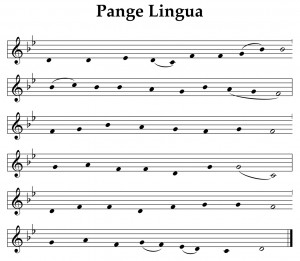 Pange Lingua Gloriosi Corporis Mysterium is a hymn written by St Thomas Aquinas (1225–1274) for the Feast of Corpus Christi. It is also sung on Holy Thursday, during the procession from the church to the place where the Blessed Sacrament is kept until Good Friday. The last two stanzas, called separately Tantum Ergo, are sung at Benediction of the Blessed Sacrament. The chant is in the Phrygian mode.
Pange Lingua Gloriosi Corporis Mysterium is a hymn written by St Thomas Aquinas (1225–1274) for the Feast of Corpus Christi. It is also sung on Holy Thursday, during the procession from the church to the place where the Blessed Sacrament is kept until Good Friday. The last two stanzas, called separately Tantum Ergo, are sung at Benediction of the Blessed Sacrament. The chant is in the Phrygian mode.
See a list of other popular chant themes here.
Videos:
Aart de Kort – Grands Jeux sur le Pange Lingua – Orgue Isnard (1774) de la Basilique St. Marie-Madeleine à St. Maximin (Provence)
Anthony Hammond – Improvisation on “Pange Lingua” – Bradford Cathedral
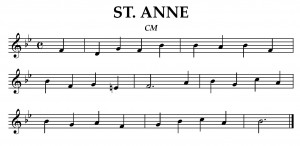 ST. ANNE was probably composed by William Croft when he was organist at St. Anne’s Church in Soho, London, England. The tune was first published in A Supplement to the New Version (1708) as a setting for Psalm 42. ST. ANNE became a setting for “O God, Our Help in Ages Past” in Hymns Ancient and Modern (1861), and the two have been linked ever since. The tune shares its first melodic motif with a number of other tunes from the early eighteenth century, most notably Bach’s great fugue in E-flat, nicknamed “St. Anne” because of the similarity of the first fugue subject to this tune.
ST. ANNE was probably composed by William Croft when he was organist at St. Anne’s Church in Soho, London, England. The tune was first published in A Supplement to the New Version (1708) as a setting for Psalm 42. ST. ANNE became a setting for “O God, Our Help in Ages Past” in Hymns Ancient and Modern (1861), and the two have been linked ever since. The tune shares its first melodic motif with a number of other tunes from the early eighteenth century, most notably Bach’s great fugue in E-flat, nicknamed “St. Anne” because of the similarity of the first fugue subject to this tune.
Videos:
Robert Summers Potterton, III – Improvisation on ST. ANNE – St. Luke’s Lutheran Church: Dedham, MA